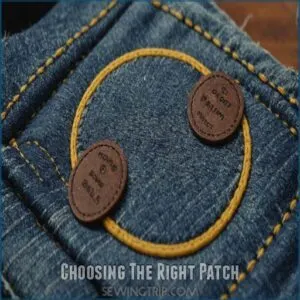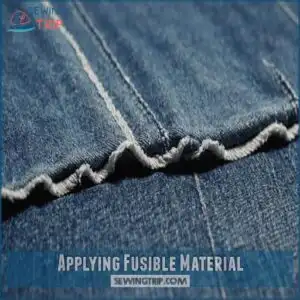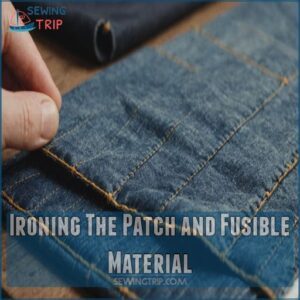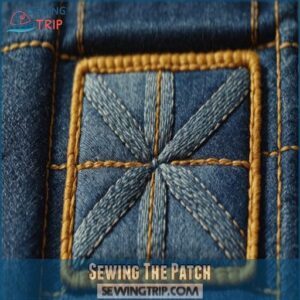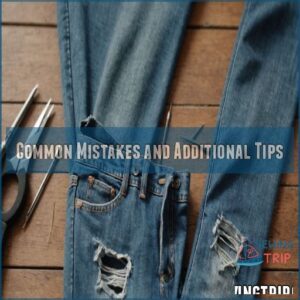This site is supported by our readers. We may earn a commission, at no cost to you, if you purchase through links.
 To sew a patch on jeans, start by selecting a suitable patch or fabric, ensuring it matches the jeans’ color and texture.
To sew a patch on jeans, start by selecting a suitable patch or fabric, ensuring it matches the jeans’ color and texture.
Trim frayed edges around the hole, then cut the patch about half an inch larger than the hole on all sides.
Flip your jeans inside-out, laying them flat, and position the patch over the hole, securing it with pins.
Sew along the patch’s edges using a zigzag stitch, which is known for its stretch and durability, especially when used for reinforcing seams or adding decorative elements, such as with contrasting thread by using a technique found in this hand sewing guide, either by hand or with a sewing machine.
This method fixes holes but can also add style.
Stay tuned for unique techniques that can transform your patchwork into art!
Table Of Contents
- Key Takeaways
- Choosing The Right Patch
- Preparing The Jeans for Patching
- Applying Fusible Material
- Attaching The Patch
- Sewing The Patch
- Alternative Sewing Methods
- Common Mistakes and Additional Tips
- Sewing Patches by Hand
- Sewing Patches With a Sewing Machine
- Finishing Touches and Decorative Patching
- Frequently Asked Questions (FAQs)
- Conclusion
Key Takeaways
- Match your patch to the weight and stretch of your jeans for a natural look and comfortable fit.
- Align the grain lines when attaching your patch to prevent awkward pulling and twisting.
- Secure the patch with sturdy stitching, like a zigzag or straight stitch, for durability through washes and wear.
- Use fabric-specific adhesives and heavy-duty thread to ensure the patch stays in place without damaging your denim.
Choosing The Right Patch
You’ll need to match your patch’s weight and stretch to your jeans for a repair that looks and feels natural.
Before you start sewing, make sure your patch is slightly larger than the damaged area and aligns with the fabric’s grain lines for the best results.
Matching Weight and Stretch
When patching jeans, matching the weight and stretch of your patch material to your denim is important for durability and comfort. You wouldn’t want a stiff patch on stretchy jeans – it’ll feel like wearing cardboard!
- Test patch elasticity by gently stretching it alongside your jeans
- Compare thickness by layering both materials
- Check if both fabrics have similar texture
- Make sure the patch moves naturally with your jeans’ stretch
Grain Line Alignment
Getting your patch’s grain line right is like making sure your dance partner’s moving in sync with you.
This involves understanding the concept of fabric grain and pattern placement, which is essential for preventing awkward pulling and twisting that can make your repair look wonky.
Just match the vertical threads of both fabrics, and you’re golden.
Hole Repair and Stabilization
Before adding your patch, you’ll need to tackle that hole like a pro.
Think of it as giving your jeans a solid foundation – just like you wouldn’t build a house on shaky ground.
Here’s how to stabilize that tear:
- Apply fray check around the hole’s edges to prevent further damage
- Use darning techniques to create a supportive base
- Place stabilizing fabric behind larger holes for extra reinforcement
Keep the area flat and smooth for perfect patch placement later.
Selecting The Right Fabric Glue
The right fabric glue can make or break your patch job.
You’ll want to stick with glues specifically designed for denim – look for labels mentioning "permanent bond" or "heavy-duty fabric adhesive."
Apply a thin, even layer and let it dry completely (usually 24 hours) before wearing.
Skip common craft glues or super glue – they’ll just make a mess and won’t hold up in the wash.
Preparing The Jeans for Patching
You’ll need to get your jeans ready for their repair makeover by trimming any frayed edges and clearing away loose threads that could interfere with the patching process.
After you’ve cleaned up the area, turn your jeans inside out and smooth the fabric on a flat surface, making sure to position the damaged area where you can easily work on it.
Trimming The Edges of The Rip
Start with clean, sharp scissors to trim those jagged edges around your jean’s rip, making sure to use matching needle and thread for a seamless repair.
You’ll want to create straight, even lines – think of it like giving your denim a neat haircut.
Work slowly around the tear, removing any frayed or uneven edges that could cause problems later.
Just don’t get carried away – you’re aiming for clean edges, not a bigger hole!
Removing Fuzz Balls and Smoothening The Material
Once you’ve got clean edges on your rip, tackle those pesky fuzz balls with a fabric shaver or pill remover.
Run it gently over the area surrounding your tear to prevent future fraying.
Next, smooth out any wrinkles or creases with a warm iron on medium heat, keeping the denim flat and even.
This prep work’s like giving your jeans a mini spa day—they’ll thank you later!
Positioning The Jeans and Tucking in The Legs
After smoothing out those pesky fabric wrinkles, lay your jeans on an ironing board or any flat, sturdy surface.
Make sure you’ve got plenty of working space around you.
You can find all the necessary tools, such as a fabric patch kit, to help you with this process.
Flip the jeans inside out and carefully tuck in the legs, making both seams visible.
You’ll want to line everything up neatly – think of it like making your bed, but with denim.
Applying Fusible Material
You’ll need fusible material to create a strong foundation for your patch, acting like a sturdy frame around the rip in your jeans.
Once you’ve measured the tear’s dimensions, you’ll cut thin strips of fusible material to line each edge, giving your patch the perfect support it needs to stay in place.
Measuring The Edges of The Rip
Take your measuring tape and get the exact dimensions of that rip – think of it like mapping out territory for a tiny fabric renovation.
You’ll want both the length and width, making sure to measure the full extent of any fraying.
Pro tip: add an extra half-inch on each side for good measure.
Jot these numbers down; you’ll need them for the next step.
Cutting and Lining Fusible Strips
Four precise cuts of fusible strips will give your repair the professional touch it needs.
You’ll want to measure each strip to match your rip’s dimensions perfectly.
Here’s how to line them up:
- Cut strips slightly wider than the tear’s edge
- Position strips about 1/4 inch from the rip’s border
- Overlap corners for extra reinforcement
- Press strips lightly to hold them in place
Creating a Frame Around The Rip
Once you’ve got your fusible strips in place, create a sturdy frame by overlapping them around the rip’s perimeter.
You’ll want the strips to extend about 1/2 inch beyond the tear’s edges.
Press each strip with your iron for 10-15 seconds, keeping the iron moving to prevent scorching.
This frame provides essential support and prevents the tear from spreading.
Attaching The Patch
You’ll want to select a patch that’s slightly larger than your rip, making sure it overlaps the fusible material you’ve already applied.
Once you’ve positioned your patch correctly over the tear, you can secure it temporarily with pins and press it firmly with a medium-heat iron to bond everything together.
Selecting The Right Patch Size
When choosing your patch size, aim for about half an inch larger than the rip on all sides.
You can also check out denim patch size options for more guidance.
You’ll want enough overlap to make sure a strong attachment but not so much that it looks bulky.
Cut your patch into a rounded rectangle or oval shape – these shapes prevent fraying better than squares.
Match the patch material and color to your jeans for a seamless look.
Centering The Patch Over The Rip
A well-centered patch is like a bullseye – it’s essential for both function and looks.
Start by positioning your patch directly over the rip, leaving equal overlap on all sides.
Smooth out any wrinkles or bubbles with your fingers, working from the center outward.
For the best results, pin the patch in place at four corners, ensuring even tension across the fabric.
Using Premade Denim or Leftover Fabric
Inside your sewing kit, you’ll find two main patch options for your jeans: premade denim patches or recycled fabric from old pairs.
Both choices work great, but here’s what to keep in mind:
- Premade patches often come with adhesive backing for easier placement
- Old jeans provide perfect color and weight matching
- Dark patches can cover light jeans, but not vice versa
- Quality denim scraps last longer than synthetic alternatives
- Local fabric stores often sell pre-cut denim patches
Ironing The Patch and Fusible Material
Now that you’ve got your denim patch ready, let’s heat things up.
When ironing on a patch, it’s important to keep in mind the backpack material guidelines.
Set your iron to medium heat without steam – think warm enough to bond but not hot enough to scorch.
Place a pressing cloth over your patch and fusible material, then apply firm, even pressure for 15-20 seconds.
Move the iron in small circles to make sure every spot gets proper heat treatment.
Sewing The Patch
You’ll start creating the classic X-pattern stitch by threading your needle with sturdy thread that matches your jeans’ color and securing it with a strong knot.
Once you’ve anchored your thread, you’ll sew through the patch’s corners and work your way around the perimeter three times, ensuring your repair will last through countless washes and wear.
Threading The Needle and Knotting The Thread
After securing your patch, grab a sturdy sewing needle and thread that matches your jeans’ color.
Double the thread’s length to about 24 inches, then thread it through the needle’s eye.
Here’s a pro tip: moistening the thread’s end helps it slide right through.
Pull both ends even, and tie them together with a double knot – you’re ready to start stitching!
Sewing The Corner and Creating an X Stitch
Start by pressing your needle through one corner of the patch, securing it with a small backstitch.
Create your first diagonal line across the corner, pulling the thread snug but not tight enough to pucker.
Then, cross back over that line to form your X-stitch.
This creates a strong anchor point that’ll keep your patch from lifting.
Repeat this X-stitch at each corner.
Cross-Stitching and Sewing Around The Perimeter
Create durable cross-stitches by forming "X" patterns along each edge of your patch.
You’ll want to sew around the entire perimeter three times – think of it like building a fortress around your repair.
Keep your stitches close together, about 1/8 inch apart, and maintain even tension throughout.
This triple-reinforcement technique guarantees your patch stays put through countless washes and wear.
Alternative Sewing Methods
You’ll find several creative ways to attach your patches, from rustic whip stitches to seamless invisible stitching methods.
Whether you prefer the handmade charm of blanket stitches or the efficiency of a sewing machine, you can choose the technique that matches your style and skill level.
Whip Stitches for a Rustic Charm
Whip stitches bring a rugged, handmade charm to your patched jeans that’s impossible to get with a machine.
To get the most out of whip stitches, you need to master the technique using the right tools, such as needles and thread, which are among the essential hand sewing supplies.
Here’s what makes whip stitches shine:
- Creates visible, parallel lines that catch the eye
- Works perfectly with thick denim thread
- Adds texture and dimension to plain patches
- Holds stronger than basic straight stitches
- Gives your jeans that coveted vintage look
For best results, use thread that matches your jeans’ color, keeping stitches evenly spaced and pulled tight.
Blanket Stitches for a Handmade Aesthetic
Blanket stitches take your patch game to the next level, adding a handmade touch that’s both decorative and durable.
This classic stitch creates a distinctive border around your patch, almost like a mini fence holding everything in place.
You’ll work the thread in a loop pattern, catching both the patch and jean fabric.
Keep your stitches evenly spaced for that Pinterest-worthy finish.
Invisible Stitches for a Seamless Look
Invisible stitches using techniques like patching jeans with fabric can elevate the repair process. Invisible stitches transform your patched jeans from obvious repairs to seamless upgrades.
You’ll want to catch the patch from underneath while keeping the thread hidden beneath the jeans’ edge.
This technique requires patience but delivers professional results that’ll make your repair virtually undetectable.
For best results, use a specialized denim sewing needle to guarantee smooth, even stitches that won’t damage the fabric.
- Thread that perfectly matches your jeans’ color
- A thin needle that slips easily through denim layers
- Tiny, consistent stitches spaced 1/8 inch apart
- Hidden knots tucked between fabric layers
- Strategic patch placement that follows the fabric’s natural lines
Sewing Machine Stitches for Accessibility
A sewing machine makes quick work of patch attachment, offering both speed and durability.
You’ll want to use your machine’s free arm for hard-to-reach spots on pant legs.
| Stitch Type | Best For | Tips |
|---|---|---|
| Straight | Basic patches | Use short length |
| Zig-zag | Stretchy fabric | Set width narrow |
| Satin | Decorative edges | Slow down speed |
For maximum hold, stitch twice around the perimeter, overlapping your starting point by an inch.
Common Mistakes and Additional Tips
You’ll save yourself hours of frustration and endless do-overs by knowing the most common patch-sewing mistakes before you start.
From choosing the wrong patch weight to skipping proper hole repair, these practical tips will help you nail your jean repair on the first try.
Patch Weight Mismatch and Grain Line Alignment
Getting your patch’s weight right isn’t just about matching colors.
Your patch should feel similar to your jeans – too stiff and it’ll stick out like a sore thumb, too light and it’ll tear easily.
To make sure you’re using the right needles for your denim, consider choosing heavy-duty needles for a strong and durable stitch.
When you’re lining up your patch, check the grain lines (those tiny parallel threads) and make sure they match your jeans’ direction.
This keeps everything moving naturally when you wear them.
Insufficient Hole Repair and Weak Stitching
A hole in your jeans can quickly turn into a bigger disaster without proper repair.
Before you start patching, you’ll need to address the damage carefully to prevent future tears.
Here are three important steps that’ll save your favorite pair:
- Trim any loose threads or frayed edges
- Stabilize the area with darning or fusible interfacing
- Use small, dense stitches for maximum durability
Using Inappropriate Adhesives and Thread Choice
Many DIY enthusiasts make the mistake of using regular craft glue, which can damage your denim and lead to peeling patches.
Stick to fabric-specific adhesives that flex with your jeans.
For thread, you’ll want something sturdy – regular all-purpose thread just won’t cut it.
Choose a heavy-duty polyester or cotton thread that matches your jeans’ color, ideally in size 40 or higher.
Hand-Stitching Techniques and Machine Stitching
Proper hand-stitching starts with selecting the right needle size for your denim’s weight.
You’ll want to keep your stitches small and tight – think rice grain size – for maximum durability.
When machine stitching, adjust your thread tension to medium-high and use a shorter stitch length.
Pro tip: test your settings on a scrap piece first to avoid any rookie mistakes.
Sewing Patches by Hand
You’ll be amazed at how simple it’s to sew patches by hand once you’ve got your supplies ready and your patch positioned just right.
Whether you’re fixing a tear or adding some personal flair, mastering common hand stitches uses can greatly enhance your hand sewing skills, giving you complete control over every stitch and letting you work at your own pace.
Positioning The Patch and Pinning in Place
Now that you’ve chosen your patch, let’s make sure it stays put while you work.
Place your patch exactly where you want it on your jeans, making sure it fully covers any damage with about 1/2 inch extra all around.
Here’s what to do next:
- Position the patch with its grain matching your jeans
- Secure corners with straight pins
- Add pins around the edges, spacing them 1 inch apart
Threading The Needle and Sewing a Straight Stitch
Once your patch is securely pinned, thread your needle with a length of strong thread – about arm’s length works best.
Double the thread and tie a solid knot at the end.
Start your straight stitch by pushing the needle up through both layers from underneath.
Keep your stitches small and even, about 1/8 inch apart, working your way around the patch’s edge.
Sewing Patches With a Sewing Machine
You’ll save time and create stronger, more professional-looking repairs when you use a best sewing machine for patches to attach patches to your jeans.
With the right thread color and stitch settings, you can quickly secure your patch while maintaining a clean, polished appearance that’ll last through countless washes.
Choosing The Right Thread Color
Thread color makes or breaks your patch job.
When using a sewing machine, pick a thread that either matches your jeans perfectly or complements your patch’s border – there’s no middle ground here.
Dark blue thread works like a charm on classic denim, while black thread‘s your go-to for darker washes.
Remember, lightweight thread won’t cut it – stick to heavy-duty options for lasting results.
Selecting a Straight Stitch With a Short Stitch Length
With your chosen thread ready to go, set your machine to a straight stitch – it’s your best friend for patch work.
Keep the stitch length short, around 1.5-2mm, which creates a tight, secure hold.
You’ll want this density to prevent the patch from lifting or fraying over time.
Take it slow at first, especially around corners, letting the feed dogs guide your work smoothly.
Backstitching for Added Durability
Your short stitch length is set, now let’s make it bulletproof.
Backstitching at the start and end of your patch isn’t just good practice – it’s your insurance policy against unraveling.
Hit that reverse button for about 4-5 stitches at each end.
Think of it like double-knotting your shoelaces – a few extra seconds now saves you from future patch mishaps.
Finishing Touches and Decorative Patching
You’ll learn how to add those final professional touches to your patched jeans, including proper thread trimming and secure fabric bonding.
With your newfound patching skills, you can even create custom DIY designs that’ll make your repaired jeans look better than new.
Trimming Excess Thread and Ironing The Patch
Once you’ve finished sewing, make those final touches count. Here’s how to get that professional look:
- Snip excess threads close to the stitches using sharp scissors
- Turn your jeans right-side out and lay them flat
- Set your iron to medium heat without steam
- Press firmly around the patch edges for 30 seconds, moving in circular motions
Now you’ve got a patch that looks store-bought perfect!
Using Fabric Glue for Secure Bonding
Fabric glue adds an extra layer of security to your patched jeans, especially in high-stress areas.
Apply a thin, even layer of denim-specific fabric glue around the patch edges, pressing firmly for 30 seconds.
Let it dry for 24 hours before washing.
Pro tip: test the glue on a scrap piece first – some glues can leave visible residue or stiffen the fabric.
Creating DIY
Ready to express your creativity? Making DIY patches lets you express your unique style.
Transform your favorite emojis into embroidered designs, use stamps to craft custom shapes, or try cross-stitching for intricate patterns.
Just remember to make your patches slightly larger than needed and choose colors that complement your jeans.
It’s like having a tiny canvas for your personal masterpiece.
Frequently Asked Questions (FAQs)
Can you sew a patch on jeans?
Absolutely, you can tackle that wardrobe malfunction with flair!
Just grab a patch, align it over the rip, and use sturdy stitches to secure it.
Make sure the patch blends well, and voilà, jeans saved!
How do you sew jeans patches on a sewing machine?
Position your patch, select a straight stitch, and sew! Backstitch at the start and end for extra hold. A short stitch length makes sure it won’t come loose. Easy peasy!
How do I choose the right patch for my jeans?
Choosing a patch for your jeans? Like picking toppings for a pizza—balance is key!
Choose one matching the fabric’s weight and stretch.
Align the grain line for comfort, and avoid stiff, thin, or mismatched artwork.
How do you make a patch on jeans?
Start by choosing your fabric and design.
Cut the patch slightly larger than the hole.
Position it, pin in place, and sew using strong thread with a needle or a sewing machine.
Secure with finishing stitches.
How do you sew patches on jeans?
Think adding patches is rocket science? It’s not!
First, cut a suitable patch slightly bigger than the rip.
Use a strong thread and needle for hand stitching, or a sewing machine for speed. For hand stitching, consider using a technique like the invisible ladder stitch for seams, or a sewing machine for speed.
Secure tightly.
What is the best stitch for patching jeans?
For patching jeans, choosing the right thread and fabric weight is crucial to ensure a strong and long-lasting repair, a zigzag stitch or straight stitch with a sewing machine provides durability and flexibility.
Hand-sewn invisible stitches work well for a seamless look, while whip stitches add a rustic touch.
How do you fix a hole in jeans with a patch?
When life gives you lemons, patch them!
Trim frayed edges, choose a matching patch, and iron fusible material over the hole.
Sew the patch with strong stitches, securing it tightly.
Explore unique designs for added flair.
How to sew a repair patch?
To sew a repair patch, trim the frayed edges, then pin the patch over the hole.
Use matching thread to stitch, beginning with a solid backstitch for security.
Press the patch afterwards for a neat finish.
How do I remove an old patch?
Remember that time you tried to remove a stubborn sticker?
Carefully cut away the threads, then gently peel the patch.
Use a seam ripper for stubborn stitches.
A little patience goes a long way!
What tools are needed for patching jeans?
You’ll need a needle, strong thread, scissors, a patch, and an iron to patch jeans.
Add fusible material and interfacing for extra strength.
A sewing machine can speed things up, but hand sewing gives control.
Can patches be removed without damage?
Removing patches without a trace feels like magic.
Use a seam ripper for threads.
Gently peel off glue patches with heat.
Test fabric reactions.
Some discoloration is possible, but patience helps maintain your jeans’ look.
How to match patch color to jeans?
Choose a patch that closely matches your jeans’ color by comparing it under similar lighting.
Using small swatches or photos helps.
Consider texture and fade; denim often looks different indoors versus outdoors.
Are iron-on patches durable for jeans?
Imagine iron-on patches as the quick fixers of the jean world—they’re not perfect.
While convenient, they often lack long-term durability and might need reinforcement with stitching for heavy wear or frequent washing to truly last.
Conclusion
Ultimately, knowing how to sew a patch on jeans can save your favorite pair from the trash and give them a unique touch.
By carefully selecting the right patch and method, you can mend those rips effectively.
Remember, using a sewing machine or stitching by hand, each step you take reinforces your jeans’ durability and style.
With practice, you’ll find patching jeans restores them but also offers an opportunity to express your creativity.

